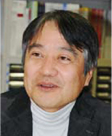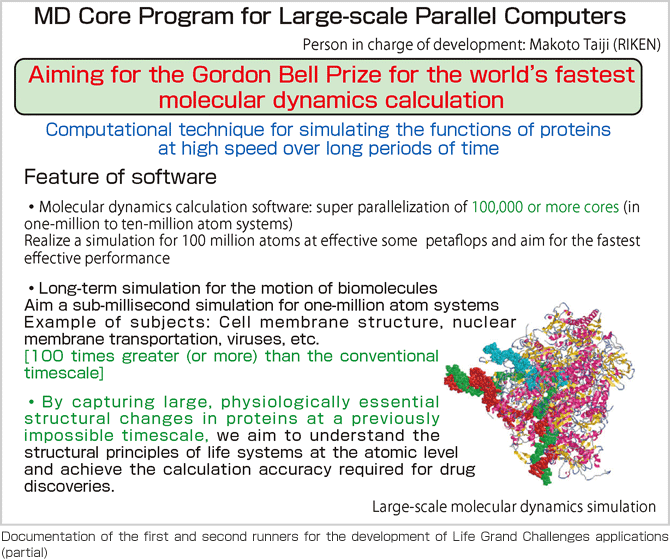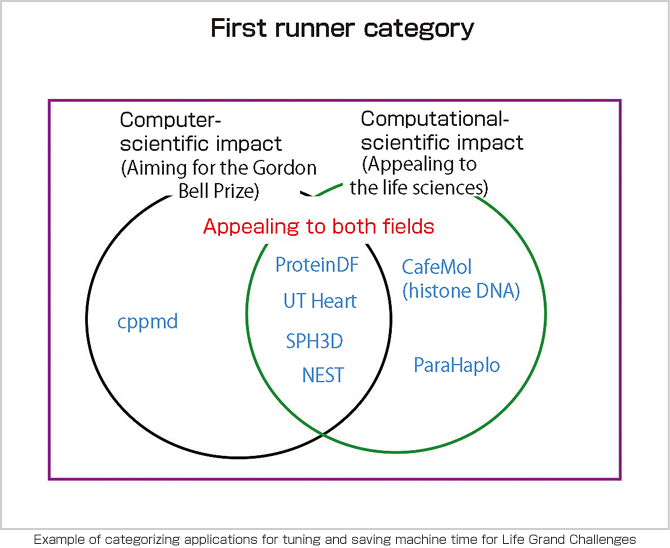
Biosupercomputing: Carving out the Future of Life Sciences Research
Aiming to Become a Global Trendsetter in
the Life Sciences by Making the Best Use
of the Next-generation Supercomputer!
As the base of life sciences research in developing "Grand Challenges" applications for the next-generation supercomputer project, RIKEN has been tackling "Next-Generation Integrated Simulation of Living Matter" and proposed "biosupercomputing" as a new field of study. Currently, RIKEN and researchers in the fourteen participating organizations have been developing software that makes the best use of the petaflopscale next-generation supercomputer. Many people have great expectations for "biosupercomputing" to lead the world by establishing new methods in the life sciences based on advanced computational science.

Computational Science Research Program
Deputy Program Director
Ryutaro HIMENO
■Searching for explanations of life phenomena through computational scientific approaches
Until recently, the royal road to understanding the life sciences has been laboratory work. Computers have mainly been used to organize experimental data. Experimental technologies and methods, such as highthroughput experimental equipment, super high-speed sequencers, genetic modification technology and single molecule imaging, have rapidly improved and have been involved in the clarification of many factors. On the other hand, since many detailed factors have become clear, researchers grappling with experimental research have started to feel that the distance to an essential understanding of life phenomena has been increasing. This is why we started to explore the use of computers to understand life phenomena.
The computational performance of supercomputers has continued to improve by approximately ten times every 3.8 years for the last twenty years. As performance improves, the fields of research that yield practical applications have changed. First, supercomputers made it possible to solve the problems of architectural structure and then fluid mechanics. Supercomputers can now process large-scale experimental data, such as the calculation of nano-materials and the analysis of the human genome. Ultimately, with the development of the next-generation supercomputer, which will have computational performance measured in petaflops, the day is coming when we can probe and explain various phenomena inside living matter based on the physical equations of atoms and molecules.
What we found by the development of experimental research is that life phenomena are far too complicated for the human brain to comprehend. To deal with this, we can input the rules of life phenomena observed into computers and organize and test them. This will allow us to be able to identify the life phenomena that can be explained and those that cannot. In addition, it will be possible to predict and control life phenomena based on prediction. As a tool of computational scientific approaches related to life phenomena, the use of supercomputers is now grabbing attention. We can say that this is a change in thinking from "biology describing phenomena" to "biology predicting a new phenomenon."This is also a proposal of new ways of using supercomputers that are radically different from the conventional, and orthodox methods used in engineering and physics.

"The First Runners"for the Development of Life Grand Challenges Applications
| Application name | Person in charge of development | Description | Purpose |
|---|---|---|---|
| MD core program for large-scale parallel computers (cppmd) | Makoto Taiji (RIKEN) |
Computation technique for simulating the functions of proteins at high speed over long periods of time | Aim to win the Gordon Bell Prize for the world fastest molecular dynamics calculation |
| All-electron wave function calculation for proteins based on density functional theory (ProteinDF) | Fumitoshi Sato (The University of Tokyo) |
Computational science and technology for accurately elucidating the reaction of proteins at the electronic level | Aiming at the world's largest allelectron calculation for proteins |
| Multi-scale, multi-physics heart simulation(UT Heart) | Toshiaki Hisada (The University of Tokyo) |
Globally unprecedented, world's largest simulation of a virtual heart in a computer | Aiming at the simulation of an entire heart from the myocardial cell level |
| Whole-body voxel simulation (Voxel structure fluid coupling analysis program SPH3D) | Shu Takagi (RIKEN) |
Computational science and technology suitable for analyzing and predicting a soft human body for medical applications | Aiming at the simultaneous simulation of creation, transportation and infarction of a thrombus |
| Neural Simulation Tool(NEST) | Marcus Diesmann (RIKEN) |
Elucidates whether it is possible to explain the activities of an actual brain based on a simple neuron model | Aiming at creating the world's largest action simulation of a cerebral cortex focal neurological circuit |
| Coarse-grained model calculation(CafeMol) | Shoji Takada (Kyoto University) |
Elucidates the mechanism of the winding and unwinding of DNA onto the histone in a nucleus | Explains the mechanism of a great length of DNA stored in and read from a nucleus when necessary |
| Statistical test software for haplotype analysis (ParaHaplo) | Naoyuki Kamatani (RIKEN) |
Elucidates the relation of individual genetic information to diseases and drug responses | Explains the relationships of diseases and drug responses to gene and environmental factors for fortyseven diseases |
■Leading the world by new thinking
Currently, we are taking on the following three challenges by using the next-generation supercomputer. First, as described above, the challenge of reorganizing obtained knowledge and information, sorting out what is not understood, making predictions and controlling phenomena to understand life phenomena in total. Second, the challenge of explaining various phenomena inside the human body based on the laws of physics for atoms and molecules. Third, the challenge of simulating a human body in a computer, in the same way car crashes and earthquake wave simulations are simulated, so that we can probe the human body according to its physical properties and each organ (such as the heart) and find surgical methods that will yield practical applications for the medical field.
The challenge of an overall understanding of life phenomena is one of the most important assignments for the life sciences in the 21st century. Many researchers around the world feel the necessity of computational scientific approaches in the life sciences. Under these circumstances, what we have to do is to make a major course correction that changes the conventional research methods used in the life sciences. By quickly starting to take on the challenge of this assignment and by being a trendsetter, we believe that our research will have a considerable ripple effect on the world. Japan is about to be the first nation in the world to start down this path by having this great tool, the next-generation supercomputer. In addition, the many researchers of the "All Japan team" are cooperating to achieve this significant goal. "Biosupercomputing" has tremendous potential to lead the world in this field. At the very least, it will be able to play the role of trendsetter in leading us in a new direction.
■Developing software for actual operation
Aiming for the full-operation of the next-generation supercomputer (in 2012), applications for thirty-some themes have currently been developed in the life sciences. Among them, we focus on seven applications as the "first runners" to achieve a great result as soon as the full-operation begins. To select the first runners, we considered the following criteria: calculation is possible only by utilizing the performance of the next-generation supercomputer, the outcome is scientific and has high value for application to the life sciences and the application can have an impact immediately after the start of operations. This does not mean that we are ranking the applications in terms of the scientific meaning. What is more important is the level of perfection of the application and whether the calculation is making the best use of the next-generation supercomputer.
For example, the "MD core program for large-scale parallel computers (cppmd)" is a computation technique to simulate the functions of proteins at high speed over long periods of time based on the physical laws in the atomic and molecular world. We would like to achieve the world’s fastest molecular dynamics calculation to win the Gordon Bell Prize. The Gordon Bell Prize is given to the project that achieves the best results through the use of parallel computers for practical scientific computing.
We have 6 more first runners other than the MD core program. Some of these are expected to achieve great results, including those that have a chance of winning the Gordon Bell Prize and others that will show that Japanese research is leading the world. We hope that these first runners prove the superior computational performance of the next-generation supercomputer as fulloperation begins and promote the high performance and future potential provided by "biosupercomputing." After the first runners, twelve "second runners" are waiting. Some of them are expected to have significant impact on the development of medical treatment and pharmaceuticals, while others still are research that is unique to Japan. Finally, the "third runners" are waiting to aim for results that will have global impact in a wider range of areas.

BioSupercomputing Newsletter Vol.2
- SPECIAL INTERVIEW
- Aiming to Become a Global Trendsetter in the Life Sciences by Making the Best Use of the Next-generation Supercomputer!
Computational Science Research Program Deputy Program Director
Ryutaro HIMENO
- A Message from the Team Leader
- Simulating Cell Phenomena by Recreating Cells as They Exist in Living Organisms
Cell Scale Team Team Leader
Hideo YOKOTA - Create a Brain on a Supercomputer to Unravel the Functions of the Brain and Nervous System
Brain and Neural Systems Team Team Leader
Shin ISHII - High-performance Computing Environment to Maximize the Potential of the Next-generation Supercomputer
High-performance Computing Team Team Leader
Makoto TAIJI
- Report on Research
- Protein Reaction Simulation Based on All-electron Calculation
Institute of Industrial Science, the University of Tokyo
Fumitoshi SATO / Toshiyuki HIRANO / Noriko UEMURA / Naoki TSUNEKAWA / Junichi MATSUDA - Full Eulerian Fluid-structure Coupled Method
Associate Professor at School of Engineering, the University of Tokyo
Kazuyasu SUGIYAMA - A Large-scale Simulation Model of Cortical Microcircuits: CMDN(Cortical Microcircuit Developed on NEST)
Brain and Neural System Team
Jun IGARASHI - Development of Next-generation Molecular Dynamics Simulation Programs
High-performance Computing Team
Hiroshi KOYAMA / Yosuke OHNO / Gen MASUMOTO / Aki HASEGAWA / Gentaro MORIMOTO
